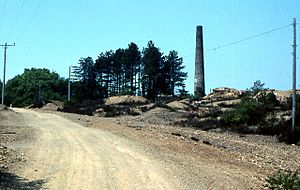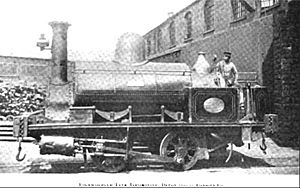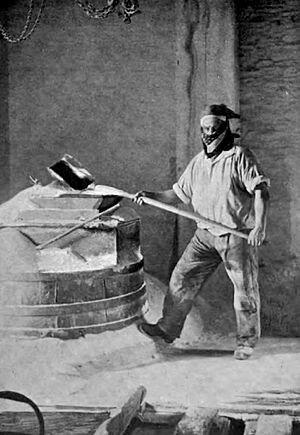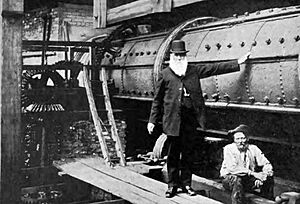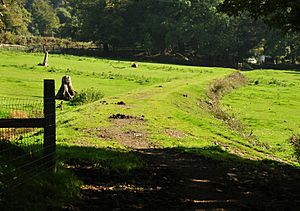Devon Great Consols facts for kids
Devon Great Consols was a very important copper mine located near Tavistock in Devon, England. A group of investors started the mine in 1844. They leased the land from the Duke of Bedford. Even though earlier attempts to find copper there had failed, these new investors were determined to succeed.
Work began in August 1844. By November, they found a huge amount of copper ore deep underground. The copper vein was so big, stretching for over two miles, that the company quickly opened more mines nearby. Devon Great Consols soon became one of the most productive copper mines in the world!
Contents
History of Devon Great Consols Mine
In the early to mid-1800s, the counties of Devon and Cornwall were famous for their copper mines. Many people hoped to get rich by investing in new mines. While some mines made huge profits, many others failed. The land that became Devon Great Consols had been tried before, but no one had found much copper.
Starting the Mine: A Risky Business
A group of six investors, led by Josiah Hugh Hitchens, decided to take a chance. They put in £1,024 to start a new mine. On July 26, 1844, they signed a 21-year lease with the Duke of Bedford. The mine was first called Wheal Maria, named after the Duke's wife. Wheal is a Cornish word that means 'a place of work,' often used for mines.
Work started in August 1844. Just a few months later, in November, they struck it rich! They found a large copper vein about 20 fathoms (around 36 meters or 120 feet) deep. This vein was about 40 feet wide and stretched for more than two miles. Because of this amazing discovery, the company quickly opened other mines nearby, like Wheal Anna Maria, Wheal Fanny, Wheal Emma, and Wheal Josiah.
Becoming the World's Top Copper Mine
By 1847, the mine was using steam engines to help with the work. But these engines were expensive to run. So, in 1849, the company found a clever way to save money: they used water power! They built three large channels, called leats, to bring water from the River Tamar to the mine. This water powered 33 wheels at the mine. On March 25, 1845, the company officially became the Devonshire Great Consolidated Copper Mining Company, or Devon Great Consols for short.
In its first six years, the mine produced nearly 90,000 tons of copper. The Duke of Bedford received £44,000 in royalties, and the investors made a huge profit of £207,000. The shares, which cost just one pound each in 1844, became incredibly valuable. By 1864, shareholders had received over £800,000 in profits! At its peak in 1864, the mine was 200 fathoms (about 365 meters or 1,200 feet) deep and employed 1,284 people, including men, boys, and women. It was known as the most productive copper mine in the world.
The mine produced so much copper that horse and wagon transport just wasn't fast enough. So, the company built its own five-mile railway! It was finished in November 1858 and connected the mine to Morwellham Quay, a port where the copper could be shipped out. Devon Great Consols was the only mine in the area to have its own railway. The railway later expanded to other mines and had three locomotives and 60 wagons.
When the mine closed, most of the railway tracks were removed and sold. However, some parts of the line were reopened in the 1920s, using a narrower track. Today, much of what's left of the railway and its buildings are protected as important historical sites.
Because of the massive amount of ore, the company also had to build its own facilities at Morwellham Quay. Between 1856 and 1858, they built a large dock and quay. The railway had a special slope, or incline, for its last half-mile to the quay. Wagons were lowered down this incline using a steam engine. They went through a tunnel and onto special bridges, called viaducts, on the quay. After the mine closed, the track was removed and the tunnel filled in, but parts were restored in 2007. The old engine house and the incline are still there. The dock was also restored later, and you can still see some of the original bollards (posts for tying up boats) and parts of a crane.
From Copper to Arsenic Production
By 1884, the copper ore from Devon Great Consols was not as good quality. It contained more arsenic than copper. The copper ore that was still good was sent to south Wales to be melted down. The company also looked for tin, but didn't find any.
As cheaper copper started coming from other countries and the mine's own copper quality dropped, Devon Great Consols found a new way to make money: arsenic! Before this, Britain had to import arsenic from Germany. But starting in 1867, Devon Great Consols began producing arsenic from the mine's waste rock.
The mine's arsenic facilities covered eight acres, and it became the largest arsenic producer in the world during the 1800s. The arsenic works at Devon Great Consols made Britain the world's biggest arsenic producer, with the mine producing more than half of Britain's total output. The mine's high-quality arsenic was in demand by industries both in Britain and other countries. About 700 people still worked at the mine in 1893.
However, low prices for arsenic and the need for money to improve the mine eventually caused problems. A plan to raise more money failed in July 1902. The company last paid profits to its shareholders in June 1899. Even though the Duke of Bedford renewed the lease, hoping the company would recover, the mine was finally closed in 1903. Its equipment was sold off that May. During its 60 years of operation, Devon Great Consols produced about 700,000 tons of copper and 72,000 tons of refined arsenic.
After the Mine Closed
By 1905, the mine property went back to the Duke of Bedford, and efforts began to clean up the site. The tall chimney and the flues (tunnels) that collected arsenic soot were destroyed with dynamite.
The site became active again for a short time during World War I. Arsenic was needed to make blister gas. During this period, tin and tungsten ore were also mined. After the war, mining for tungsten and tin stopped, but arsenic production continued until 1930. Some copper and ochre (a type of earth pigment) were recovered from the mine in the mid-1900s.
Today, the mine is part of the Cornwall and West Devon Mining Landscape World Heritage site. It has been open to the public since 2009. Many of the old buildings, like the mine captain's houses and the arsenic works, are now protected as important historical structures. In 2007, £7 million was given for restoration work on the arsenic refinery, which continued until 2014.
The land around the mine still has some chemicals from the mining days. In 2020, a study found that arsenic levels were higher than recommended safety levels. Scientists are checking the site to make sure it's safe for everyone who visits.


